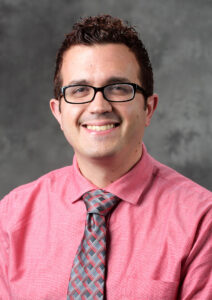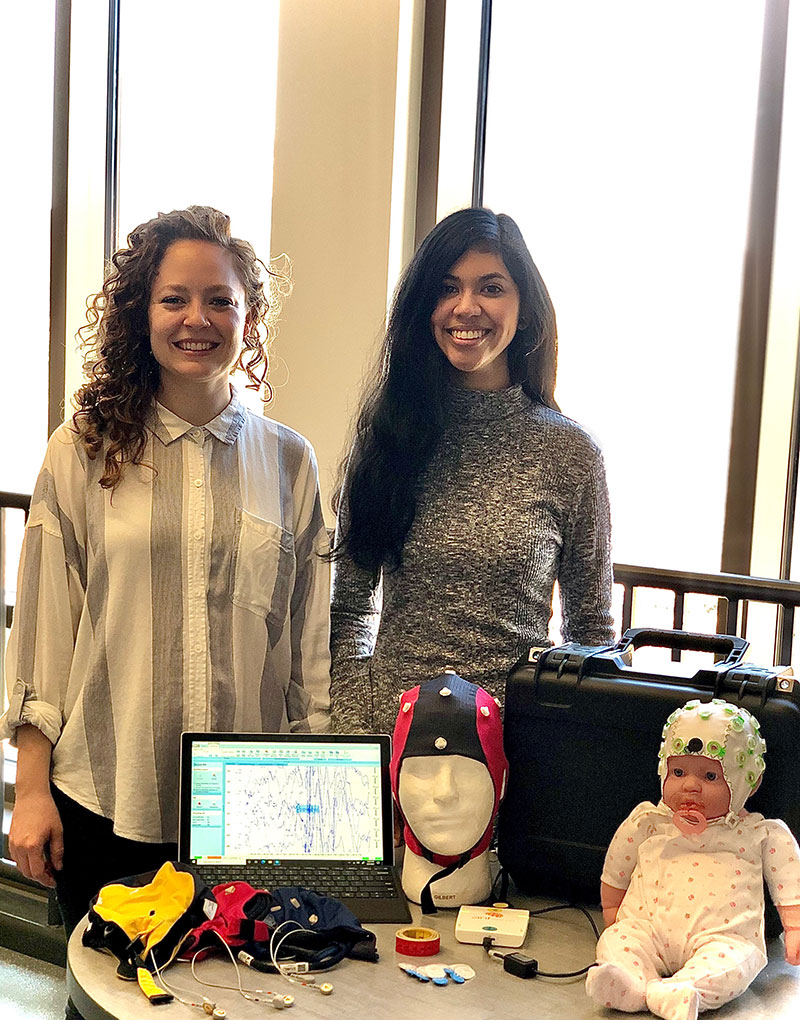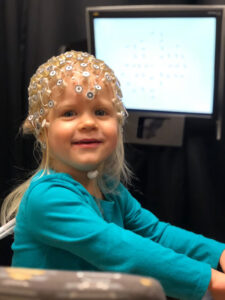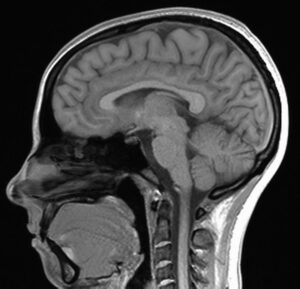Increasing access, community outreach key in Purdue neurological autism research
Written by: Tim Brouk
Researchers in Purdue University’s College of Health and Human Sciences rely on human subjects for learning more about genetic and developmental disorders like autism, Angelman syndrome and others.

Daniel Foti, associate professor of clinical psychology and neuroscience and behavior, counted on human participants coming to his Psychophysiological Analysis of Cognition, Emotion, and Reward (PACER) lab at Purdue University to participate in studies to measure brain activity through electroencephalography (EEG) and functional magnetic resonance imaging (fMRI).
“My entire career, all of my studies involved bringing participants to the lab and recording brain activity while they’re here with us in the lab,” Foti said. “We asked, ‘What if we could send equipment to families and have them record their own brain activity while we talk to them virtually and guide them through it?’”
Focusing on families affected by a genetic disorder of the nervous system called Angelman syndrome, Foti designed home kits that are about the size of a suitcase to ship to test-subject families. Included are a dry-electrode EEG cap, an amplifier and two digital tablets loaded with software that will record brain activity through video exercises and tasks.
The data Foti is receiving from these “mail-order” kits has been helpful in continuing his studies on Angelman syndrome and autism spectrum disorder (ASD). The kits increase access for families either unable or unwilling to drive sometimes hours to Foti’s lab. The families can better understand and treat disorders like Angelman syndrome or autism without leaving their home. The EEG equipment is worn by participants and measures brain activity as the participant goes through videos, images and interviews using software on the digital tablets.

The shipped equipment and data collected from the virtual exercises inform a telehealth platform project for home-based assessment of ASD and neurogenetic syndromes designed by collaborator Dr. Bridgette Kelleher, associate professor of clinical psychology and neuroscience and behavior. Foti’s project to incorporate EEG into these home-based assessments is supported by a grant through the Indiana Clinical and Translational Sciences Institute and equipment from ANT Neuro.
Foti’s concentration on home-based EEG measurement may help support clinical research efforts in the future. One goal is to increase family access to clinical trials for Angelman syndrome. A second goal is to earlier detect ASD and other developmental disorders. While the EEG measurements may not be as precise as in his lab, the data collected from at-home testing could increase the number and variety of subjects even after the COVID-19 pandemic.
“It would be helpful to reach families and communities who otherwise could not come to the lab,” Foti explained. “We’re thinking about folks in a rural setting, and they don’t want to drive three hours to do my study at Purdue. Those are the kinds of folks that are systematically excluded from these kinds of research efforts. We see this as a way to build some bridges and connect the research to families that should be involved and want to be involved but may not be able to due to logistical reasons.”
Attention in ASD

COVID-19 temporarily slowed down the lab of Brandon Keehn, associate professor of speech, language and hearing sciences, too. Inside his Attention and Neurodevelopmental Disorders (AtteND) lab, Keehn uses fMRI, EEG and eye-tracking technology to understand attentional strengths and weaknesses in children with ASD.
More recently, Keehn’s research takes him outside the lab. Supported by a grant from the National Institute of Mental Health (NIMH) and in collaboration with colleagues at the Indiana University School of Medicine, Keehn is now bringing his laboratory tools to pediatricians’ offices. There, he hopes to use eye tracking, which monitors where children are looking and the size of their pupils, to help diagnosis ASD earlier and with greater accuracy.
“When we explore our environment, we make a series of eye movements to identify where somebody may be pointing or to direct our attention to new information” Keehn said. “Individuals with autism tend to show more ‘sticky attention,’ that is they tend to get stuck on a particular object or location, and because of that, they might miss out on important learning opportunities.”

The “sticky” attention test is one that they included in their battery of tasks used in pediatricians’ offices to try to identify autism earlier. Keehn’s work also focuses on a particular circuit in the brain — the locus coeruleus norepinephrine system — which plays an important role in attention.
“From eye-tracking, we also record pupil diameter,” Keehn said. “The diameter of your pupil corresponds with the activation of this particular circuit — the bigger the pupil the greater the activation.”
Together, the sticky attention and pupil diameter tests are just two of five short eye-tracking tasks that Keehn and his colleagues are investigating. Their goal is to establish that the results from these tests are sensitive to autism so they can be used more widely to assist pediatricians in making autism diagnoses. By identifying these behavioral and biological markers, their goal is to help make an earlier, more accurate diagnosis of ASD while also determining potential targets for early behavioral interventions.
ASD Awareness
With April being National Autism Awareness Month, Keehn and Foti agree that ASD is more recognizable than ever, which has brought a steady rise in diagnoses in the United States. This means more work must be done, but there is a lot of help. When his lab is fully functioning, Foti counts 15 undergraduate research assistants ready to work. The students are eager to learn more about ASD and find ways to help families that have members with ASD.
Keehn teaches an undergraduate course on ASD, which has an enrollment of more than 100 students from many different Purdue programs.

“It’s very clear now that autism awareness is at an all-time high,” he said. “Our understanding of the lifetime costs associated with autism at an individual, family and societal level increases our need for research into identifying ASD earlier. The earlier a child is diagnosed and enters early intervention, the better their outcomes are and therefore, the lower their lifetime costs.”
Courtney Mallory worked with children and adults with ASD for years before she arrived as a clinical speech-language pathology master’s student. Currently, she is working with Purdue undergraduate students with ASD as part of Keehn’s research in the AtteND Lab. This work focuses on understanding how both social and non-social noise affect students with and without ASD differently. In collaboration with Dr. Rose Mason in the College of Education, their goal is to understand how difficulty filtering distracting noises may influence classroom engagement in students with ASD.
To do this, Keehn and Mallory are focusing on an area of strength in autism. They are using a visual search task – for example, finding an L in a bunch of T’s. Keehn’s previous research has shown that individuals with autism do this faster than their non-autistic peers. By showing that noise adversely affects performance in an area of strength and that this is related to reduced classroom engagement, they hope to better understand how we might be able to modify classroom environments or develop approaches to improve attention in ASD.
“We’re looking to change the environments,” Mallory said. “Would using more noise-absorbing materials to reduce background white noise that could be distracting enhance these students’ learning? For in-class group work, how should the students spread out? What about the best instructor voice amplification systems?”
For the past two years, Mallory has worked to improve the lives of individuals with ASD at Purdue and advocate for them.
“I think a lot of times they can be stereotyped,” said Mallory, noting she has family and friends with ASD. “I think there are lot of strengths that go unnoticed that can be incredible. We want to help them engage and support them to do what they want to do like everyone else.”
Getting different perspectives into PACER, AtteND and the Purdue Autism Research Center is essential in learning more about prevalent disorders like autism — pandemic or not. More research is needed to understand the most effective ways to diagnose autism accurately and early. More research into effective, personalized interventions is needed, too. Purdue researchers are up to the tasks.
“What’s particularly exciting to me is to see the sheer variety of research methods that are being brought to the table to answer the questions: What is autism? What causes it? And what can we do about it to help folks live fulfilling lives?” Foti said. “We’re running the gamut of looking at the cellular level — how do individual types of neurons change? — in a very fine-grain way in animal models and kiddos with autism. We’re conducting intervention studies and finding new therapies. Broadly, that’s what the field will need — no one lab will answer these things.”